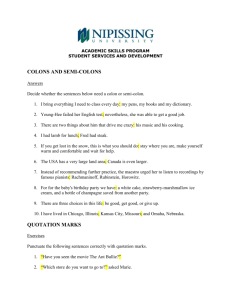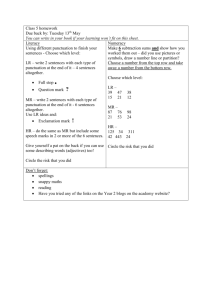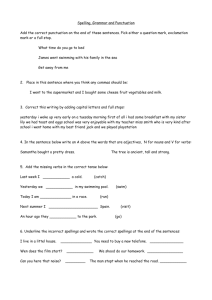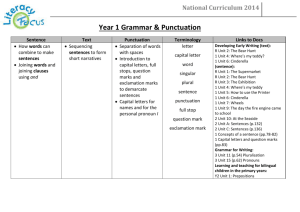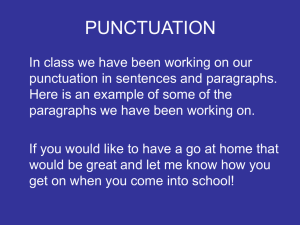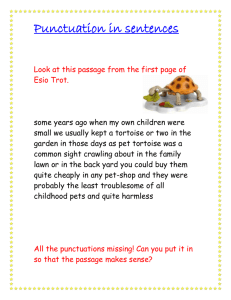Unit 3 Life Lesson
advertisement
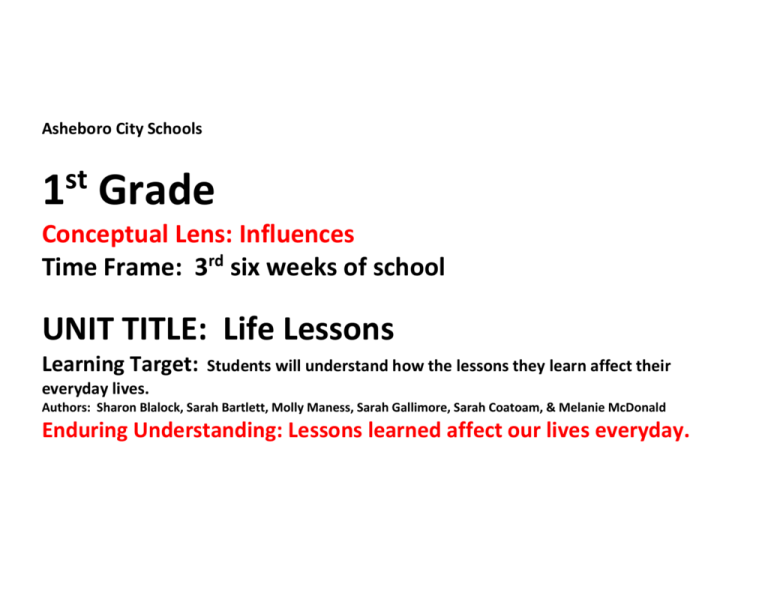
Asheboro City Schools st 1 Grade Conceptual Lens: Influences Time Frame: 3rd six weeks of school UNIT TITLE: Life Lessons Learning Target: Students will understand how the lessons they learn affect their everyday lives. Authors: Sharon Blalock, Sarah Bartlett, Molly Maness, Sarah Gallimore, Sarah Coatoam, & Melanie McDonald Enduring Understanding: Lessons learned affect our lives everyday. Social Studies Geography and Environmental Literacy 1. G.2.2 Explain how people use natural resources in the community. 1. G.2.3 Explain how the environment impacts where people live (urban, rural, weather, transportation, etc.). Concept: “Influences” Standards Economics and Financial Literacy 1. E.1.1 Summarize the various ways in which people earn and use money for goods and services. 1. E.1.2 Identify examples of goods and services in the home, school and community. 1. E.1.3 Explain how supply and demand affects the choices families and communities make. Life Lessons Health Mental and Emotional Health 1. MEH.1.1 Use effective communication to express and cope with emotions 1. MEH.1.2 Use methods of positive coping with disappointment and failure 1. MEH.1.3 Classify stressors as eustress or distress. Personal and Consumer Health 1. PCH.1.1 Recognize that germs produce illness and can be spread from one person to another 1. PCH.1.2 Use measures for preventing the spread of germs 1. PCH.2.1 Illustrate symptoms of sickness and measures for getting well. 1. PCH.3.1 Identify safety hazards in the home and injury prevention strategies 1. PCH.3.2 Identify items that can cause burns, strategies to prevent fire and burn injury 1. PCH.3.3 Execute the Stop, Drop, and Roll response. 1. PCH.3.4 Execute an emergency phone call. English Language Arts RL.1.3: Describe characters, settings, and major events in a story, using key details. RL.1.2: Retell stories, including key details, and demonstrate understanding of the central message or lesson. RI.1.6: Distinguish between information provided by pictures or other illustrations and information provided by the words in a text. W.1.3: Write narratives in which they recount two or more appropriately sequenced events, include some details regarding what happened, use temporal words to signal event order, and provide some sense of closure. L.1.2: Demonstrate command of the conventions of standard English capitalization, punctuation, and spelling when writing. L.1.2(b): Use end punctuation for sentences. RF.1.4: Read with sufficient accuracy and fluency to support comprehension. RF.1.4(b): Read on-level text orally with accuracy, appropriate rate, and expression on successive readings. Learning Target: Students will understand how the lessons they learn affect their everyday lives. Structure of Knowledge Unit Title Learning Target: (Suggested Schedule/ Change to meet your needs) Safety Life Lessons Economic Life Lessons Geography Life Lessons Safety Hazards Emergency Procedures Money Goods and Services Supply and Demand Natural Resources Environmental Impacts How Understanding Safety is a Life Lesson How Our Economic Literacy is a Life Lesson How Our Geographic Literacy is a Life Lesson Students will understand necessary steps to identify, prevent and respond to unintentional injury. Students will understand basic economic concepts. Students will understand goods and services with respect to ways people earn and use money as well as examples within the home, school and community. They will be able to explain how supply and demand affect choices. Students will understand how humans and the environment interact within the local community. Stage 1 – Desired Results Learning Target: Standards Common Core State Standards and North Carolina Essential Standards Understandings What do students need to understand? Questions What guiding questions will foster inquiry, understanding, and transfer of learning? Content What do students need to know? Skills Learning Targets What do students (I can statements) need to be able to do? Social Studies Economics and Financial Literacy 1.E.1.1 Summarize the various ways in which people earn and use money for goods and services. Students will need to understand that people need to work in order to earn money and that people use money to purchase goods and services. Why do we need to earn money? What are some examples of ways to earn money? What are some jobs that we pay people to do? (services) What are some things that we purchase with money? (goods) People use money they earn to buy goods and services Businesses incur costs by hiring individuals and earn revenue by selling goods and services Individuals earn income by working for various businesses Distinguish between goods and services Students will be able to explain how people earn money and ways they use it. Students will be able to distinguish between goods and services. I can tell the different ways people earn and use money. 1.E.1.2 Identify examples of goods and services in the home, school and community. Students will need to understand the difference between goods and services and that producers and consumers impact goods and services. What are some examples of goods and services at home? At school? In our community? Goods are food, clothing, etc. Sevices are fireman, policeman, lawn maintenance care takers, banking, etc. The difference between goods and services. Students will be able to give examples of goods and services. (home, school, and community) I can give examples of goods and services. 1.E.1.3 Explain how supply and demand affects the choices families and communities make. Students will need to understand the concept of supply and demand. That supply and demand may influence choices that families and communities make. Students will need to know that scarcity impacts lives and its role in decisionmaking. What does the term “supply” mean? “demand” mean? Can you give examples of scarcity in the classroom? (what do we need more of) Why is it scarce? How do our choices affect supply and demand in our classroom? The process of making choices using available resources and why people cannot have everything that they want. The definition of supply and demand. Students will be able to explain how supply and demand affect choices they make in their lives. Students will be able to define supply and demand. I can explain supply and demand and how it affects the choices we make. Social Studies Geography and Environmental Literacy 1.G.2.2 Explain how people use natural resources in the community. Students will need to understand what natural resources and how humans use natural resources in their everyday lives. What are natural resources? Can you give some examples of natural resources? Can you explain ways in which we use natural resources? A natural resource is something from Earth that people use. Some examples of natural resources are rocks, minerals, land, soil, water, air & animals and plants. Students will be able to list natural resources. Students will be able to explain ways we use natural resources. I can name natural resources. I can tell ways that we use natural resources. 1.G.2.3 Explain how the environment impacts where people live (urban, rural, weather, transportation, etc.) Health Education Personal and Consumer Health 1.PCH.3.1 Identify safety hazards in the home and injury prevention strategies. Students will need to understand how the environment impacts where they live. Students will understand that there are various safety hazards in the home that can lead to injuries and how it is an important life lesson to know prevention strategies to stay safe. How does weather impact where you live? What type of transportation do you use in your community? What does Urban mean? What does Rural mean? How would you describe the area in which you live? People live in different types of environments; urban and rural. Weather impacts how we live; how we dress; what we eat; what we do for fun; transportation. Why is it important to stay safe? What are safety hazards? What are examples of safety hazards in the home? What are examples of preventions strategies? It is important to understand and identify safety hazards and prevention strategies in order to stay safe. Students will be able to explain different types of environments. Students will be able to explain how the weather impacts their community. I can explain what an urban/rural community is. I can explain how the environment plays a part in our day to day lives. Students will be able to explain different types of transportation in their community and how the weather impacts how they get around. Students will be able to identify safety hazards in the home. Students will be able to explain how to prevent injuries in and around their home. I can identify safety hazards in my home. I can identify prevention strategies. I can explain why safety is important. 1.PCH.3.2 Identify items that can cause burns, strategies to prevent fire and burn injury. Students will understand the importance of fire safety through the awareness of items that cause fires & burns, as well as how prevent fire and burn injuries. 1.PCH.3.3 Execute the Stop, Drop, and Roll response. Students will understand the importance of the stop, drop, and roll response, as well as how to perform the procedure. 1.PCH.3.4 Execute an emergency phone call. Students will understand that you dial 911 for an emergency. Why is fire safety important? What are examples of items that can cause burns? What are examples of strategies to prevent fires? What are examples of strategies to prevent burns? Why do we stop, drop and roll? The importance of fire Students will be able safety. to list items that may cause burns. Items that can cause burns & strategies to Students will be able prevent fire and burn to explain how to injury. prevent fire and burn injuries. How do we stop, drop, and roll? If clothing is on fire, we stop running, drop to the floor and drop to the ground and then roll around to extinguish the fire. Students will understand that using this process will help extinguish a fire; as appose to running which may allow the Students will know fire to spread. what classifies as an emergency. What is an emergency? How do you dial numbers on a phone? When should you call 911? The importance of stop, drop and roll. Students will know how to use a keypad on a telephone. I can explain why fire safety is important. I can identify examples of items that cause burns. I can identify examples of strategies to prevent fires and burns. Students need to I can stop, drop, and know how to execute roll. the stop, drop and roll response. Students will know how to make an emergency phone call and explain how to do it. Students will be able to give an example of a situation that classifies as an emergency. I can dial 911 in an emergency. I can give examples of situations that could be emergencies. English/ Language Arts Students will understand that there are different elements of a story including characters, settings, events, and key details. Who are the characters? Where is the setting? What happened in the story? How can we generate descriptive words about the characters and the setting? Students will know that fiction consist of elements that include setting, characters, and major events. RL.1.2: Retell stories, including key details, and demonstrate understanding of the central message or lesson. Students will understand that retelling the story can help them understand the central message. What happened at the beginning? Middle? End of the story? Students will know that stories consist of a beginning, middle and end. Students will include key details to demonstrate their understanding of the central message of the story. RI.1.6: Distinguish between information provided by pictures or other illustrations and information provided by the words in a text. Students will understand that they can use the illustrations to gather information about a story. Students will understand that they can use the words to gather information about a story. What is happening in the pictures? Do the words match the picture? Can you gather information from the text and illustrations? Students will know that they can use pictures and the text to gain information about the story. Students can read the text to generate a list of details. Students can also use illustrations to gather information about the story. RL.1.3: Describe characters, settings, and major events in a story, using key details. Students will be able to give examples of the characters and generate a list of descriptive words about the characters. They will identify elements of a story. (setting, events, details, and characters) Students will be able to use words and pictures to illustrate story details and messages. Students will be able to cover the text and rephrase the story. I can identify characters, settings, and major events of a story. Students will view pictures in text prior to reading and generate lists of details observed from the pictures. I can use the pictures and the words to help me understand the story. I can retell a story. W.1.3: Write narratives in which they recount two or more appropriately sequenced events, include some details regarding what happened, use temporal words to signal event order, and provide some sense of closure. L.1.2: Demonstrate command of the conventions of standard English capitalization, punctuation, and spelling when writing. Students will understand that narrative writing consists of a personal experience. Students will understand that their narrative writing should include sequenced events and some sense of closure. Students understand that some words must begin with a capital letter, sentences must end with punctuation, and many words may be spelled phonetically. Can you think of something in your life, get a picture in your mind, and then draw and write about it? Can you write about an event using the words first, next and last? Students will know how to write a narrative using sequential order. Students will need to be able to recall 2 or more sequenced events, including details. Students will be able to use temporal words to signal event order and provide some sense of closure. Imagine that you are reading a story and there are no capitals and no periods. Would that be a problem? Would we be able to understand the story? Students know to begin a sentence and names with a capital letter. Students know how to end a sentence with punctuation. Students know how to spell untaught words phonetically. Students will be able to write a narrative using 2 or more sequenced events and provide closure. Students will be able to write stories to describe special days or events from personal experiences. I can write a story about myself. I can tell a story across my fingers, and produce a story that has a beginning, middle, and end. They will use details in sequential order to describe the date/events. Students have daily opportunities to practice writing that requires capitals, ending, punctuation, and spelling phonetically. I can capitalize names, places, and dates. I can punctuate sentences correctly with a period, question mark, or exclamation mark. I can spell untaught words phonetically. L.1.2(b): Use end punctuation for sentences. Students understand that sentences end with punctuation. Imagine that you are reading a story and there are no periods. Would you be able to understand the story? How does ending punctuation help us understand what we are reading? Do sentences always end in a period? What other punctuation might you need at the end of a sentence? Students know that sentences that end with periods, exclamation points, or question marks. Students have daily opportunities to practice writing and punctuating different types of sentences. I can punctuate sentences correctly with a period, exclamation point, or question mark. RF.1.4: Read with sufficient accuracy and fluency to support comprehension. Students understand how to read fluently to understand the meaning of text. How does the way you read help you understand words and the meaning of text? Students need to know what fluent reading is and how to read fluently. Students will have frequent opportunities to practice reading fluently and answering comprehension questions. I can read fluently and use fluency to understand texts. RF.1.4(b): Read onlevel text orally with accuracy, appropriate rate, and expression on successive readings. Students understand how to read fluently and with expression. Does the way that we read out-loud matter? How can make our oral reading more interesting to our audience? What does it mean to read with expression? Students need to understand punctuation (i.e. periods, exclamation points, commas, question marks) and sentence structure. Students have daily opportunities to read out-loud to practice their fluently and expression on appropriate text level. I can orally read with fluency and expression. Stage 2 – Assessment Evidence What forms of assessment will demonstrate that the student has acquired the knowledge, understanding, and skills taught during unit 3? Performance Task for Component 1 and Scoring Rubric for Safety Life Lessons Through what authentic performance task(s) will students demonstrate the desired understandings? Students will understand that there are safety hazards in the home that can lead to injuries and that is an important life lesson to know prevention strategies to stay safe. Standards for Safety Life Lessons: 1.PCH.3.1,1.PCH.3.2, 1.PCH.3.3, 1.PCH.3.4, L.1.2a, L.1.2b Goal: To help your classmates increase their knowledge concerning safety techniques. Role: 1st Grade Student Audience: Classmates are your target audience. Situation/Scenario: Some students in the class are not aware of safety techniques in regards to safety hazards in the home or fire safety strategies. The teacher is concerned and has asked the students to contribute their knowledge to increase safety awareness among their classmates. Product Performance and Purpose: In partners, students will select a safety hazard scenario. You will discuss ways to execute/prevent the safety strategy in the scenario. Using the strategy that you have selected, you will illustrate and write to explain the best practice for resolving the situation. Student partnerships will present their completed work, share their thinking, and answer questions from the class. Expectations (Criteria for Success): Discuss the safety hazards with your partner and identify ways to deal with the hazard in a safe manner. Create a poster that illustrates the best way to deal with the safety hazard. Write to explain how to identify the safety hazard and to prevent injury. Present and explain your completed poster to the class, share your thinking, and answer questions from the class. Choose a Classroom Conflict Scenario Option or Create Your Own Scenario: Juan was at his house helping his mother cook dinner. He noticed the door to the dishwasher was open and could see knives in the utensil basket sticking up and washing detergent in the dispenser. What can Juan and his mother do to resolve this hazard? Sally and her mom are decorating the Christmas tree. She notices that the extension cord has many frayed wires and the electrical socket is cracked. How can Sally and her mother resolve this hazard? Adam was at a bonfire and was cooking marshmallows. One of the coals from the fire fell out onto Adam’s pants and began to burn. What should Adam to put the fire out and to keep it from spreading? At the family meeting, the Lopez family wanted to come up with a plan for ways to exit their home in case of a fire. What can they do to make sure that everyone could get out of the home safely? How can they make sure everyone got out of the burning home? Emily was playing outside when she noticed smoke coming from the house next door. What should she do? Scoring Rubric for Component 1 Performance Task Fantastic (4 PTS.) Nice Work (3 PTS.) Keep Working (2 PTS.) Just Beginning (1 PT.) Content The student demonstrates outstanding details and quality about understanding safety hazards. The student demonstrates adequate details and quality about understanding safety hazards. The student demonstrates few details and limited quality about understanding safety hazards. The student did not demonstrate understanding of safety hazards. The quality is inadequate. Writing All sight words are spelled correctly. Harder words are stretched. All punctuation is placed appropriately. Most sight words are spelled correctly. Harder words are stretched. Most punctuation is placed appropriately. Few sight words are spelled correctly. Harder words are not stretched. Not enough spacing between words. Few punctuation marks are placed appropriately. Unintelligible spelling. Not enough spacing. Punctuation is inconsistent. Presentation Voice quality is effective including appropriate rate and enthusiasm. The speaker responds very well to questions. Voice quality is almost effective including rate and enthusiasm. The speaker responds sufficiently to questions. Voice quality is somewhat effective including rate and enthusiasm. The speaker responds nearly sufficient to questions. Voice quality is limited including appropriate rate and enthusiasm. The speaker does not respond well to questions. Achievement of Purpose/Under standing: Shows complete understanding of the required assignment. The solution completely addresses all components in the task. Shows nearly complete understanding of the required assignment. The solution nearly completes addresses all components in the task. Shows some understanding of the required assignment. The solution addresses some of the components in the task. Shows limited or no understanding of the required assignment. The solution addresses limited or not understanding all components in the task. Grade Scale Less than 8 points = 1, 9 to 11 points = 2, 12-14 points=3, 15-16 points=4 Total Points Stage 2 – Assessment Evidence What forms of assessment will demonstrate that the student has acquired the knowledge, understanding, and skills taught during unit 3? Performance Task for Component 2 and Scoring Rubric for Economic Life Lessons Through what authentic performance task(s) will students demonstrate the desired understandings? Students will understand goods and services with respect to ways people earn and use money. Standards : 1.E.1.1, 1.E.1.2, 1.E.1.3 Goal: Students will earn compensation for completing a craft with-in a given amount of time. Role: 1st Grade Student Audience: Classmates are your target audience Product Performance and Purpose: Students will be participating in a Santa’s Workshop. The students will be divided into 4 or 5 groups depending on the number of students in the classroom. Each group of students will be given a Christmas craft to complete in a given amount of time. Some examples of Christmas crafts would be a bookmark, Christmas cards, or an ornament. Students will make as many of their craft as possible in their time frame (suggested time frame would be at least 30 minutes.) After working hard at making their Christmas craft, the students would get paid for their productiveness for that day. You can create your own pay scale to accommodate your students. They will put their money earned into the bank each day after working. You may create a bank for each student or use a baggie. You may also have one student who provides a service by being the banker. Students will create a brochure explaining how they created the good that they produced. At the end of the week, students will count the money they have in the bank to find out how much they have earned while working. The goods the students created will be priced according to the supply of the good and demand of the buyers. It is okay to not have enough of one craft for every student to buy one, and it is okay for everyone to be able to buy more than one of some crafts. This will affect the supply and demand for the craft. The students will buy Christmas gifts for their family and friends using their money. They will be able to see how money is earned and how supply and demand can affect how much something costs. Expectations (Criteria for Success): Students will work together in small groups for a set period of time. (30-40 minutes for 4 days) At the end of each day, students will receive compensation for their completed work. Students will create a brochure explaining how they created their good in their group. At the end of the week, students will take their earning to purchase crafts available in the classroom. * We are suggesting doing this unit around Christmas incorporating making Christmas gifts for students’ families. However, we understand that not all students celebrate Christmas or you may want to do this at a different time of the unit. Please feel free to change this idea into a Toy Workshop or Gifts for Friends at your discretion. Scoring Rubric for Component 2 Performance Task Fantastic (4 PTS.) Nice Work (3 PTS.) Keep Working (2 PTS.) Just Beginning (1 PT.) Content Works well with others all of the time. Shares ideas and collaborates with peers. Works well with others most of the time. Only shares some ideas and collaborates with peers most of the times. Rarely cooperates well with others. Never shares ideas or collaborates with peers. Did not work well at all with peers. Many issues with collaboration and sharing of ideas. Writing Created a thorough, detailed, and well-designed product. Created a detailed product that was mostly welldesigned and thought out. Created an average product that was somewhat designed and planned. Did not create any product or demonstrate any planning. Presentation The student can accurately answer any questions related to the brochure and to processes used to create product. Brochure is attractive in design. The student can accurately answer most questions related to the brochure and to processes used to create product. Brochure is somewhat attractive in design. The student can accurately answer 1-2 questions related to the brochure and to processes used to create product. Brochure is lacking in detail and design. The student appears to have little knowledge of the brochure and processes used to create product. Overall design of brochure needs work. Achievement of Purpose/Under standing: Student worked on the task until it was completed and continued working even when difficulties arose. Student worked on the task until it was completed and tried to work through difficulties. Student put some effort into the task, but stopped working when difficulties arose. Student put very little effort into the task. Grade Scale Less than 8 points = 1, 9 to 11 points = 2, 12-14 points=3, 15-16 points=4 Total Points Stage 2 – Assessment Evidence What forms of assessment will demonstrate that the student has acquired the knowledge, understanding, and skills taught during unit 1? Performance Task for Component 3 and Scoring Rubric for Geography Life Lessons Through what authentic performance task(s) will students demonstrate the desired understandings? Students will be able to understand how humans use natural resources in their everyday lives. Standards : 1.G.2.2, 1.G.2.3, L.1.2 (a), L.1.2 (b), RF.1.4 (a) Goal: Students will be able to list natural resources and tell where they are found and how they can be used. Role: You are a first grade student. Audience: Your classmates are your target audience. Product Performance and Purpose: Each student will select one of the following natural resources: rocks and minerals, soil, water, air, or plants. Students will use the models for scaffolding on the following pages of the Macmillan McGraw Hill Science teacher edition – unit D - D15, D21, D25, D31. Students will tell where the natural resource is found and how it is used. After using the graphic organizer, students will write an informational piece about their chosen natural resource. After completing the informational piece, students will present it to the class. Students will be prepared to answer any questions from their classmates. Expectations (Criteria for Success): Students will choose a natural resource and complete their graphic organizer using information they have learned. Using the information from the graphic organizer, students will write an informational piece about their natural resource. They will tell where it is found and how it is used. Students will present their writing to the class and answer any questions from their classmates. Optional: Each student could create a poster showing how their natural resource is used by humans along with their writing to share with the class. Scoring Rubric for Component 3 Performance Task Fantastic (4 PTS.) Nice Work (3 PTS.) Keep Working (2 PTS.) Just Beginning (1 PT.) Content Information is very organized with well-constructed sentences. Information is organized with mostly wellconstructed sentences. Information is organized, but sentences are not wellconstructed. Information appears to be disorganized. Writing Information clearly relates to the topic. It includes several details. Information clearly relates to the topic. It provides 1-2 supporting details. Information relates to the main topic. No details are given. Information has little or nothing to do with the topic. Presentation Graphic organizer has been completed and shows clear relationships between all topics. Graphic organizer has been completed and shows clear relationships between most topics. Graphic organizer has been started and includes some topics. Graphic organizer has not been attempted. Achievement of Purpose/Under standing: Well-rehearsed with smooth delivery that holds audience attention. Rehearsed with fairly smooth delivery that holds audience attention most of the time. Delivery not smooth, but able to maintain interest of audience most of the time. Delivery not smooth and audience attention often lost. Grade Scale Less than 8 points = 1, 9 to 11 points = 2, 12-14 points=3, 15-16 points=4 Total Points Stage 3 – Learning Plan Learning Target: Students will understand how the lessons they learn affect their everyday lives. Safety Life Lessons Students will understand necessary steps to identify, prevent and respond to unintentional injury. Teacher Notes Possible Learning Activities and Resources Books: Firefighter A to Z by Chris Demarist A Chair for my Mother by Vera Williams It’s Time to Call 911;What to do in an Emergency by Penton Overseas Stop, Drop and Roll by Margery Cuyler Arthur’s Fire Drill by Marc Brown Firefighter! by Angela Royston A Day with Firefighters by Jan Kottko Home Safety by Peggy Pancella Play it Safe by Mercer Mayer Home Sweet Home; A Story About Safety at Home by Cindy Leaney & Peter Wilks Technology: Brain Pop Jr. – Fire Safety United Streaming – Primary Health and Safety; I can be Safe United Streaming- Songs from Stay Safe; Essential Safety Skills www.sparky.org www.maps4kids.com http://www.smokeybear.com/kids/default.asp?js=1 Smart Exchange: Fire Safety for Kids – search fire safety, 1st grade Poems: “Fire” “I’m a Firefighter” “Dial 911” (tune of twinkle twinkle little star) -DLTK’s crafts for kids Writing Ideas for Safety Life Lessons: Have students draw a map of their home and write about 2 ways to exit in case of a fire. Decide on a family meeting place outside of the home. Explain through writing, how we can protect ourselves against fires. Hold a grade level fire safety poster contest. Winning posters may be displayed in the school. Stage 3 – Learning Plan- Continued Learning Target: Students will understand how the lessons they learn affect their everyday lives. Economic Life Lessons Students will understand basic economic concepts. Students will understand goods and services with respect to ways people earn and use money as well as examples within the home, school and community. They will be able to explain how supply and demand affect choices. Teacher Notes Possible Learning Activities and Resources Books: All About Things People Do by Lesley Smith Little Monster at Work by Mercer Mayer Curious George Takes a Job by H.A. Ray The Berenstain Bears and Mama’s New Job by Stan & Jan Berenstain Caps for Sale by Esphyr Slobodkina In my Town by Richard Scarry Corduroy by Don Freeman Something Good by Robert Munsch The Paperboy by Dav Pilkey A Chair for my Mother by Vera Williams Poems: “Goods & Services” by Charlotte Smith & Kathy Ison “Goods & Services” by Joanne Griffin Technology: Brain Pop Jr.- Goods & Services Brain Pop Jr.- Needs & Wants Brain Pop Jr.- Saving & Spending Kidsperation: Needs & Wants Sort Writing Ideas Have students create a list of goods. Beside the list of goods, have students tell whether it is grown or manufactured. Manufactured goods are clothes, computers, and cars. Grown goods are things such as fruits, vegetables, and flowers. Have students discuss the different natural resources used to produce goods. Have students write about why is it important to protect natural resources. Make a list of services people provide. Examples are dentist, bus driver, store clerk, or postal worker. Have children explain “How do people rely on each other each day” Stage 3 – Learning Plan- Continued Learning Target: Students will understand how the lessons they learn affect their everyday lives. Geography Life Lesson Students will understand how humans and the environment interact within the local community. Teacher Notes Possible Learning Activities and Resources Books (Quality Read Aloud Books for Questioning): Rocks & Minerals by Melvin & Gilda Berger I Care About Earth by Susan L. Rodgers Going for a Walk by Kana Riley Billy Fish by Edward S. Popper The Giving Tree by Shel Silverstein Tell Me, Tree by Gail Gibbons Earth’s Resources “Investigate” by Sue Barraclough Natural Resources “Investigate” by Louise Spilsbury Soil “True Books; Natural Resources” by Christian Ditchfield Oil “True Books; Natural Resources” by Christian Ditchfield Macmillian McGraw-Hill Science- Teacher Edition “Unit D Caring for Our Earth.” Poems: Collecting Rocks Piggy Bank Song by Greg and Steve Growth of a Tree by Meish Goldish Technology: Brain Pop Jr.- Natural Resources United Streaming: Natural Resources http://www.econedlink.org/interactives/index.php?iid=179&type=educator Writing Ideas Have students write about the different ways people use natural resources. For example: we use plants for clothing, medicine, food, and much more. Have students write about ways they can save natural resources. For example: we can conserve water by taking shorter showers, turning off faucets, and fixing leaky pipes. Goods and Services Goods, goods, goods, are things That we make and use. We're buying and selling And selling and buying Any goods we choose. Services are things we do That other people use. We're buying and selling And selling and buying Services that we choose. This is a song by Greg and Steve: One penny, is just a penny Five pennies, make a nickel Ten pennies, make a dime Twenty-five pennies, make a quarter Fifty pennies, make a half dollar One hundred pennies, make a dollar One dollar is what I am saving in my Piggy Bank! Growth of a Tree (to the tune of "I'm a Little Teapot") I'm a little maple, oh so small, In years ahead, I'll grow so tall! With a lot of water, sun, and air, I will soon be way up there! Deep inside the soil my roots are found, Drinking the water underground. Water from the roots my trunk receives, Then my trunk starts making leaves. As I start to climb in altitude, Leaves on my branches will make food. Soon my trunk and branches will grow wide, And I'll grow more bark outside! I will be a maple very tall, Losing my leaves when it is fall. But when it is spring, new leaves will show. How do trees grow? Now you know! By Meish Goldish Fire Can Be Helpful Fire can be helpful When handled with care But fire and children Do not make a pair! So don’t play with matches Or anything hot. Adults may use fire But children may not! By: Pauline C. Peck Fire Rap If your clothes catch on fire, don’t run or hop. The thing you have to do is come to a stop. Then drop to the ground, the floor, the dirt. Don’t worry about the mess- keep from getting hurt. When you’re down put your hands right over your face, Then roll like a log all over the place- to the left, to the right, Till the flame is out. And whenever you can, give a big shout! It might be might-ighty scary, but keep in control, You’ll start being better

